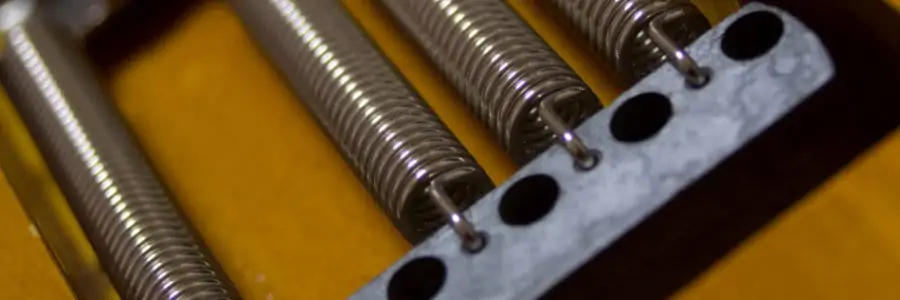If you come across buzz in the strings. You might also be thinking about the buzz that you hear is normal or not. Buzzing in the strings is not normal. Therefore, you need to understand the cause of the buzz and take the necessary steps to get rid of them. Buzz in electric guitar strings can take place due to several reasons. It can be due to a not correct technique, improper setup, or even warn parts.
Picking Or Strumming Too Hard
Cause:
When you pick or strum the notes too hard, your strings may buzz. Most of the people do this as a mistake. As a result, the strings would vibrate at a wider arc. Hence, they will make contact with the frets. That’s where you will hear the buzzing.
Solution:
You need to pick or strum a note with a specific amount of pressure. You should understand the perfect amount of strength that you should give when you are picking or strumming the guitar strings. If you experience the string buzzing and think that you picking or strumming to hard try to lower the force you apply on the strings until you don’t hear the buzz, once you reached that point you can increase to force until you hear the buzzing again and then you need to know what is the maximum amount of force you can apply.
Pressing The Strings Softly

Cause:
When you are pressing the strings, you will need to do that hard enough. Otherwise, you will experience buzzing in the strings. There is a specific amount of pressure that needs to be applied on the string and you should get to know about it as a guitarist. No matter what technique you use, it will not be possible to get positive results, if you don’t press the strings hard enough.
Solution:
When you notice the buzzing, you can go ahead and increase the amount of pressure that is being applied by your fingertips on the guitar strings. Sometimes this can deliver a painful experience to you as a beginner. However, you should ignore the pain and keep on practicing unless you feel that it is unbearable then you need to take a break for the day and return tomorrow. Then you will be able to end up identifying the ideal amount of pressure that needs to be applied to the guitar strings to overcome the annoying buzzing.
if you feel like your fingertips are not strong enough while playing then make sure to check my 11 Easy Tips on How To Toughen Up Your Fingertips
Pressing The String In The Wrong Location
Cause:
like the amount of pressure that is being applied by your fingers on the guitar string, you should also be aware of the correct location of the press. If you don’t follow the correct technique, you will not be able to end up with the best possible results while playing the guitar. Instead, you will hear a buzzing when you play.
Solution:
At the time of pressing the guitar strings to play a note, you should do it directly behind the fret. It is important for the finger to come closer to the fret as much as possible. Otherwise, the note will not be played clearly and you will have to hear the buzzing. With proper practice, you will be able to figure out the correct technique. Once you get hold of the correct technique, you can simply continue with it and overcome buzzing.
Lowering The Guitar Tuning
Cause:
Tuning levels have also been identified as a cause behind the guitar strings buzzing. Most of the players set their guitar to E standard tuning. As a result, their other settings match that tuning, the neck tension, the height of the pickup. Therefore if you change your tuning from E standard to Drop D the other settings will not match up and you may experience the buzzing.
Solution:
If you noticed the buzz in your guitar strings after you changed the tuning, you have two options for this situation. You can adjust the other settings to the new tuning, set up the neck tension and pickup heights and the bridge tension if you have a floating bridge, which I don’t recommend because you probably won’t stay in this tuning for long. The second option is doing nothing, just ignore that buzzing when you playing songs with a lower tuning, they will disappear when you will change the tuning back to E standard.
Changed Strings Thickness

Cause:
According to expert guitarists, the thickness of your guitar string can also be considered as a cause behind buzzing. The thickness of the guitar strings differs. Therefore, you need to figure out the perfect string thickness for your guitar that delivers the optimum level of play to you at the end of the day. I recommend you to go over the other causes and check them first.
Solution:
If you suspect that this may be the cause for you buzzing than I hope that checked the other causes first. First, you need to recall what was the thickness of your last guitar string, and if you see that it differs from the current one you should change it back. If you can’t remember what was the previous thickness you should try searching what is the optimal thickness of strings for your guitar or ask the shop you bought your guitar, the most popular thickness are .010 – .046 and .009 – .042.
I would start with the .009 – .042 thickness first if you are not sure with what to start. I personally use this thickness as the .010 – .046 cased my strings to buzz.
Frets Are Not In Level With Each Other
Cause:
When the frets of the electric guitar are not in level with each other, you will experience string buzzing. This can be considered as one of the most common reasons why strings on an electric guitarist buzz. Therefore, you are encouraged to pay special attention to the fact.
All the frets of your electric guitar should be at the same height. In other words, the frets should be in level with each other. But if you can see that some frets in your guitar are shorter when compared to the others, you may experience string buzzing. That’s mainly because the string will not come physically intact with all the frets. In fact, the strings will not buzz against the lower frets but will buzz when they physically get in touch with the higher frets.
Solution:
To make sure that this doesn’t happen, you need to get the frets in your fretboard into the same height. Then you can make sure that no empty space is left in between the guitar string and the fret to vibrate.
String Action Is Too Low
Cause:
String action of your electric guitar can also be considered as a culprit behind the frustrating buzz that you will experience. String action is the height of your electric guitar when measured at a given fret. The string action would differ from one fret to another. Therefore, you need to focus on the specific fret when you are determining the string action.
Guitarists usually go ahead and take string action measurements on the very first fret, twelfth fret, and the seventeenth fret. However, this depends entirely on your personal preferences. For example, some of the electric guitarists are interested in a high action whereas others are interested in going for a low action, which is also known as slamming.
Solution:
When you are setting up the low string action, there is a threshold value that you will need to keep in mind. If you can keep this threshold in mind, you will be able to stay away from the buzzing of the strings. However, it will not be an easy task to measure string action. That’s where you can think about seeking the assistance of a string action gauge. Then you will be able to take accurate measurements and determine whether your string action is too low or not. You just need to focus on setting up the string action above the threshold value. Then you will be able to stay away from the buzzing of your electric guitar strings.
Floating Bridge Too Low

Cause:
If you own an electric guitar with a floating bridge then you need to consider the tension on your bridge. If the floating bridge doesn’t have enough tension and it will go below the horizontal line of the body and the strings will touch the frets which will cause the buzz. On the other hand, having to much tension isn’t good as well. The best situation is that the bridge will be flat and parallel to a guitar’s body.
Solution:
You need to reduce or increase the tension on the bridge depending on the situation. You need to locate the part that is responsible for this, this part is called tremolo springs and they are located on the back of your guitar, right in the center. Once you removed the cover you will see 3 to 5 springs, depending on your guitar. You need to locate the screws that are closer to your guitar’s neck, they control the tension on your bridge. To lower the tension you need to screw them clockwise and to add more tension you need to screw them anticlockwise. Do a ¼ turn on each screw and then you will need to tune your strings again because you changed the tension on your strings. If the bridge isn’t flat yet you will need to repeat the process until it is.
Not Enough Neck Tension
Cause:
The neck of your electric guitar should be a straight one. However, you will not be able to discover electric guitars with perfectly straight necks at all times. Once you tune the guitar strings, you will be able to experience a slight dip in the middle of it. This dip can usually be found around the eighth fret of your guitar. This is a measurable dip. As per the guitarists, this dip is being called as the neck relief.
If there a dip in the middle of your electric guitar, you can call it a forward bow. On the other hand, some of the guitars don’t have a dip but provides a slight hump. These electric guitar necks are called as a back bow. both of these situations are not good for the guitar. However, the back bow causes the string buzz, because takes place when there is no relief in the neck and the strings touch the frets. it will be associated with the open string.
Neck relief in an electric guitar can be caused by a variety of conditions. Such as changes in humidity, temperature, and elevation, changes in string gauge or tuning are also in a position to create a poor neck relief.
Solution:
If you witness a back bow or up bow on your electric guitar, you should go ahead and take appropriate steps to fix it. All electric guitars come along with truss rods. It is located at the guitar head, close to the not slut. With the assistance of the truss rods, you will be able to go ahead and decrease or increase neck relief.
If you have a back bow you need to turn the truss rods clockwise, to tighten the stress on the neck. On the other hand, if you have an up bow you need to lose the stress on the neck and turn the truss rods anti-clockwise.
Guitar Pickups Are Too High
Cause:
The pickups on your electric guitar are made out of magnets. On the other hand, your guitar strings are made out of metal. As a result, the guitar pickups if the position to high may pull strings towards them. In fact, they can pull the guitar strings, so that they collide against the frets of your electric guitar while vibrating, which will cause the buzzing.
Solution:
In order to overcome this situation, you should go ahead and adjust the guitar pickups. It is recommended for you to adjust the guitar pickups so that the individual pole pieces would not be located closer than 3 mm from the string. You will be able to measure the distance between the pickup and strings while holding down one of your string near the 24th fret, you should check all of your strings.
Issues With The Nut Slot

Cause:
Issues found in the nut slot can also lead you towards buzzing strings. Poorly cut or worn out nut slot would make your guitar strings to be placed too close to the frets. This would not provide enough space for the guitar strings to vibrate. As a result, you face the problem.
Solution:
To overcome this problem you need to get the nut slot shim or replaced. Then you will be able to create the height that needed in between the strings and the frets. With this, you will be able to set up your electric guitar properly and get rid of buzzing. I suggest going to a professional to do the task for you, your local guitar shop will be a great stop for this job.
Worn Guitar Frets
Cause:
Along with time, your guitar frets will wear and tear. If the frets of your guitar are worn out, you may experience buzzing strings. You will notice when there is a dent in the fret.
Solution:
The solution available to you in this kind of situation is simple and straightforward. All you have to do is to go ahead and get the guitar frets replaced. I would recommend you going to the local guitar shop, so they will replace that for you, this can be a complicated and time-consuming task.
Conclusion
As you can see, you don’t have to struggle a lot to overcome the string buzz your electric guitar. Now you are aware of all possible causes that can lead the buzz. Hence, you need to pay attention to all the causes and take appropriate steps in order to overcome the problem. You just need to follow a professional approach when addressing the solutions that you have. Then you will be able to get rid of buzzing and enjoy a clear and quality sound offered by your electric guitar.
If you found this article useful, you may want to save this pin below to your Guitar board.

One thought on “12 Causes & Solutions For Buzzing Guitar Strings That Actually Work”
Leave a Reply
Recent Posts
Some guitarists insist on buying an expensive amplifier with their electric guitar. They assume that this is a must for every type of guitarist out there. However, in some situations, this isn’t...
Top 50 Free Realistic Guitar VST Plugins With Sound Examples
As technology has rapidly advanced in the recent decade, computers are stealing more and more roles from physical musical instruments and accessories. Nowadays, you do not need expensive amps,...


Although the above mentioned causes and fixes are valid ones. They don’t identify my high ‘e’ buzz issue. My open ‘e’ buzzes, and continues while fretting notes chromatically up the neck – suggesting that the problem is at the bridge. One note of mention; the bridge is a Tele Gotoh compensation, 3 saddle bridge. That, and the action is high enough to rule out low action and pup interference buzz.